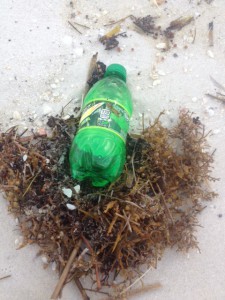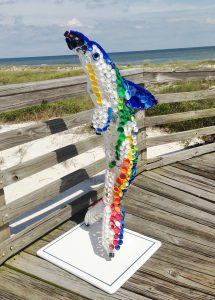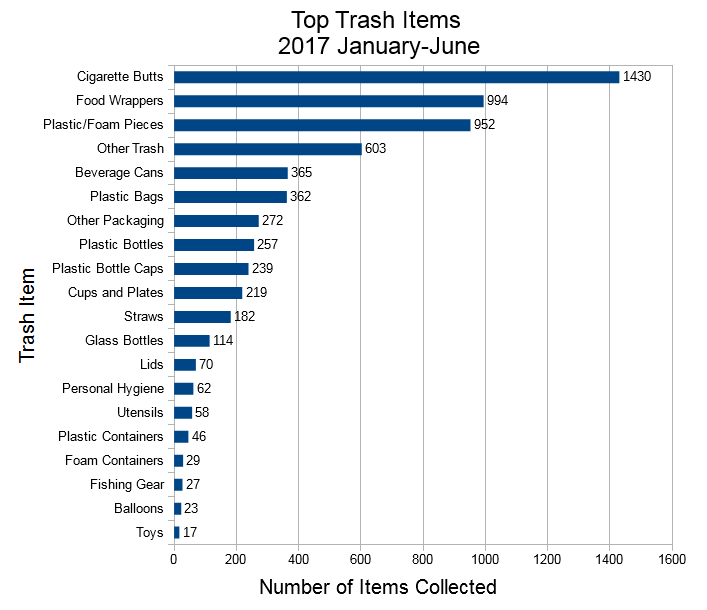
A variety of plastics ends up in the Gulf. Each is a potential problem for marine life. Photo: Rick O’Connor
Since the early 1970’s, when Chief Iron Eyes Cody shed a tear on a television commercial, we have been trying to reduce the amount of solid waste found along our beaches and within our waters. Though numerous agencies and civic groups, led by the Ocean Conservancy, have held beach and underwater clean ups over the last few decades, the problem still exist.
However, we can say this – the problems have changed. Many groups collect data while they collect the debris to determine what, and how much, has been collected. This information can give folks an idea of what the major issues are. Because of this data, aluminum can pull-tabs and glass bottles are not as common as they once were. Communities saw they were a large problem and either removed them from the market or developed ordinances that banned them from beaches – this is certainly a success story. There are agencies and researchers who compile solid waste data to let people know what they are throwing away. Once we know this, we can be more effective at reducing marine debris.
Solid waste is not just a problem for coastal beaches; it is problem throughout society. Landfills will fill up, and communities will then need another location, or a new method, to dispose of it. Though the human growth rate has declined from 1.23% to 1.11% in the last decade, we are still growing and are currently at 7.5 billion humans on the planet. Each human will require resources to survive and, thus, will generate waste that will need to be disposed of. According to a paper published in 1990, humans were generating about 550 pounds of solid waste/person/year, which generated 1.3 billion tons of solid waste each year. In 2009 that increased to 2.3 billion tons.
So how much of this solid waste is being recycled?
According to the U.S. EPA, 258 million tons of municipal solid waste was generated in the United States in 2014. 89 million tons (34%) was recycled. This is an increase from the 30% reported in many environmental science textbooks 10 years ago and <20% 20 years ago. Some states are doing much better than the national average, Washington reports they are now recycling 51.4% of their solid waste, and some nations are recycling more than 90% – so things are improving but there is room for improvement.
What is the situation in the Pensacola Bay area?
A non-profit organization called Ocean Hour cleans selected beaches for one hour every weekend. The team coordinates volunteers to help collect the debris by providing buckets, tongs, and gloves; they also dispose of the waste. Part of their mission is to provide data on what they are collecting so that the community is aware of what their largest problems are. Based on their data the top three items reported by volunteers for each year were:
| Year | #1 Item | #2 Item | #3 Item |
| 2015
|
Cigarette butts | Food wrappers | Plastic bottles |
| 2016 | Plastic bottles | Aluminum cans | Cigarette butts
Foam |
| 2017 (to date)
|
Cigarette butts | Food wrappers | Plastic and foam pieces |
The graph produced from Ocean Hour’s data by Escambia County Division of Marine Resource Intern Ethan Barker, shows all of the items they have collected this year but the bulk of it is associated with smoking and eating. Marine biologist and artist Shelly Marshall used 1200 cigarette butts collected by the Ocean Hour team to create a 3-foot sea turtle she calls CIG. She then used plastic bottles and plastic bottle caps, again collected by Ocean Hour, to create a 5-foot “bottle”nose dolphin called CAP. Both of these pieces of marine debris art are displayed at different locations in the community, and at community events, to educate the public about our marine debris problems.
So what do we do about it?
That is really up to us. Again, agencies, researchers, and non-profits have been reporting on the problem for almost five decades now. We will continue to produce waste, not much can be done there, but the question is what we will do with it. The obvious answer is dispose of properly and recycle when we can.
Cigarette Butts
- If you are a smoker, please dispose of your cigarette butt properly. There are “pocket ash trays” some folks use to keep the butt with them until they can find a place to dispose of it.
Food Wrappers – Foam
Much of the debris is related to eating – wrappers, plastic film, foam cups, straws, etc. Much of what we find is associated with this activity.
- You can use your own cup and not the foam cups provided by food establishments
- You can bring your own container to take leftovers home
- If you have to purchase food and drink with all of the wrappers and foam, and I understand that there are times you must, then do your best to dispose of properly.
Ocean Hour will continue their efforts to remove the debris from area beaches. If you can, volunteer to help now and then. You can find their schedule at https://www.oceanhourfl.com/.
If Ocean Hour is not conducting a clean up in your area, consider having your own. The Ocean Hour team can assist with the logistics of how to conduct one.
Again, we are not going to stop waste production – but maybe we can do better with waste disposal.

CIG is a sea turtle created by artist Shelly Marshall using 1200 cigarette butts collected by Ocean Hour in a 40 minute period on Pensacola Beach.
Photo: Cathy Holmes

CAP is a 4-5′ bottlenose dolphin created by artist Shelly Marshall from plastic bottles and bottle caps collected by Ocean Hour on Pensacola Beach.
Photo: Shelly Marshall
Resources:
Advancing Sustainable Materials Management: Facts and Figures. 2017. U.S. Environmental Protection Agency. https://www.epa.gov/smm/advancing-sustainable-materials-management-facts-and-figures.
Al-Salem, S.M., P. Lettieri, J. Baeyens. 2009. Recycling and Recovery Routes of Plastic Solid Waste (PSW): A Review. Waste Management. Vol 29 (10). Pp. 2625-2643. http://www.sciencedirect.com/science/article/pii/S0956053X09002190.
Miller, G.T., S.E. Spoolman. 2011. Living in the Environment; Concepts, Connections, and Solutions. Brooks/Cole Publishing. Belmont CA. 16th edition. Pp. 674.
Solid Waste Recycling. 2016. Department of Ecology. State of Washington. http://www.ecy.wa.gov/beyondwaste/bwprog_swDiverted.html.
Sullivan, C. 2017. Human Population Growth Creeps Back Up. Scientific American. https://www.scientificamerican.com/article/human-population-growth-creeps-back-up/.
WorldoMeters. 2017. http://www.worldometers.info/world-population/.
- Tips for Bear Encounters this Fall - November 10, 2025
- Pensacola Bay Invasive Species Summer Survey 2025 - November 3, 2025
- Our Environment: Part 24 – Our Changing Climate - November 3, 2025


